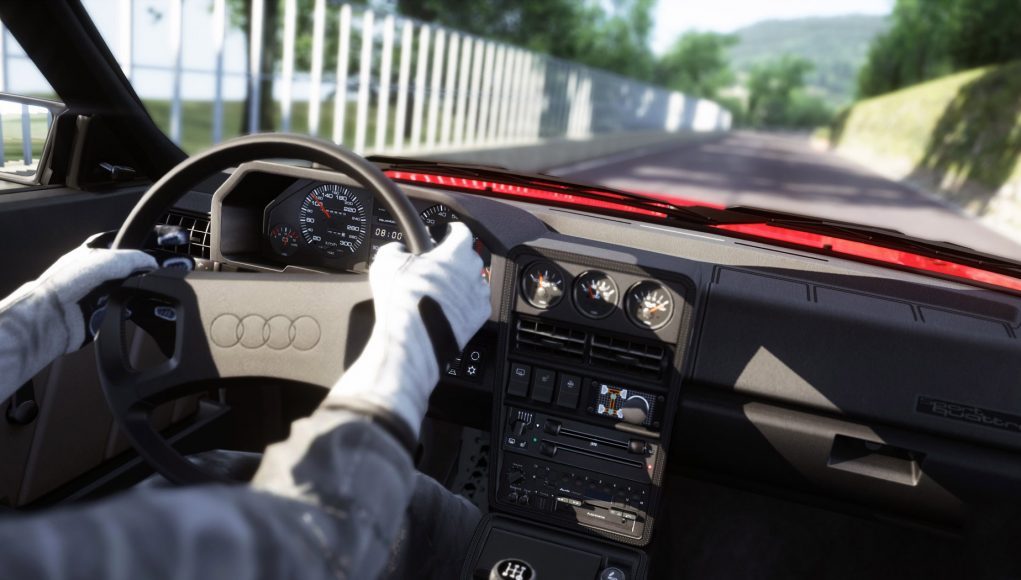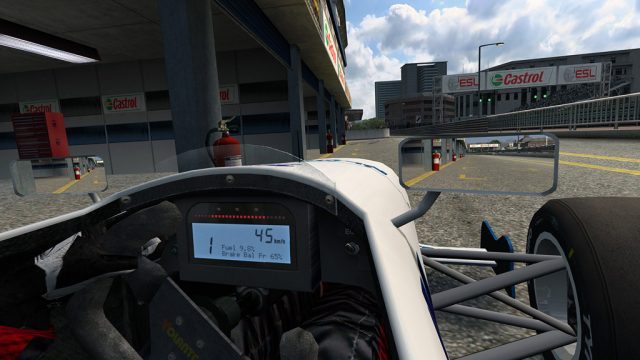As one of the first game genres to embrace VR, sim racing has successfully transitioned from the ‘very early adopter’ stage (using Oculus development kits) to the ‘early adopter’ stage (the first-generation consumer headsets). Now that the majority of PC racing sims support VR, there are several compelling options to try.
Update (10/6/17): Following the recent launch of Project CARS 2, this top 5 list has been overhauled. Every title has been re-evaluated based on its current VR features and performance.
From mid-2014 until early 2016, when the Rift DK2 was essentially the only hardware option, software support in racing simulators was a nightmare. Since then, the situation has improved, but each software solution featured here can still be considered a work-in-progress.
The HTC Vive launched on April 5th 2016, a week after the consumer Oculus Rift. The headsets shared similar specifications and, for seated games like racing sims, should have delivered a very similar experience. However, that was definitely not the case. In terms of getting development kits into the wild, Oculus had more than a two-year head start, the effects of which are still apparent today; at launch, the Vive was poorly supported by racing sims, and in some cases remained totally unsupported for months. Assetto Corsa (2014), for example, was functional on the Rift DK1 in Early Access in 2013 and had solid consumer Rift support by May 2016, but only received Vive support in March 2017.
The situation continues to improve; with the exception of Automobilista (2016), every PC racing sim (in active development) now has some form of VR support for the Vive and Rift. Below are our top five recommendations – please note, the list is weighted towards the VR implementation, not the ‘simulation value’. The truth is, depending on your sensitivity to particular contributing factors, one could justify listing these titles in almost any order, as they all feature a functional, competent VR mode – many of their differences are nuanced.
5. RaceRoom Racing Experience
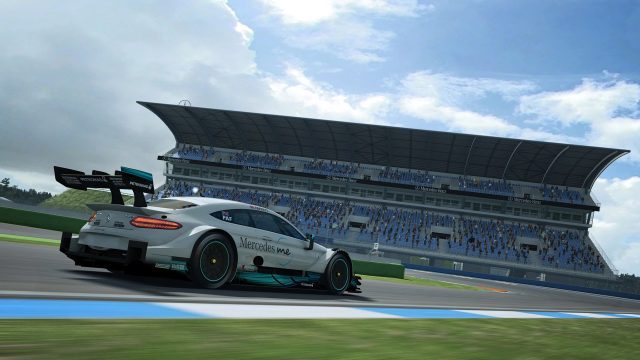
RaceRoom Racing Experience (2013) is the only ‘free-to-play’ sim on the list (most content requires purchasing). After the studio endured a challenging transition from SimBin to Sector3 in 2014, the game began to improve significantly, with a clearer direction towards realism. Today, the presentation is becoming more consistent, with many impressive track environments and detailed cars, representing the DTM series particularly well. Unlike the others on this list, the game offers three different physics models – ‘Novice’, ‘Amateur’, and ‘Get Real’, which are effectively driving assist presets. Even on the most ‘hardcore’ setting, handling is on the forgiving side, but it is a very enjoyable drive, thanks to its powerful audio design and impressive AI.
VR support in RaceRoom landed for Rift and Vive in January, and despite using a relatively old graphics engine, Sector3 delivered a solid implementation. Performance is strong on both headsets, the menus and HUD work well, and it supports supersampling and world scale adjustment.
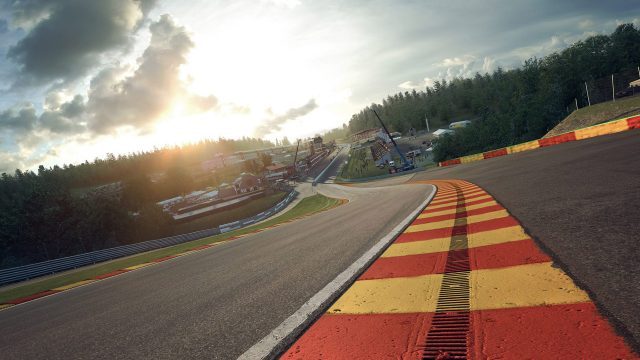
However, due to an outdated, 180-degree steering animation, along with an incomplete, poorly-proportioned driver model (with no torso), RaceRoom’s VR experience has suffered. iRacing (2008) also used 180-degree rotation for years, but has since reworked the animations across most of its cars. Sector3 has been improving in this area – every new car they release has an animation that does well beyond 180, and features a complete, more-realistic driver model. But the old steering and driver model still feature in many of the cars, including the popular DTM and GT3 series. The cars with the old animations also seem to be the most inconsistent in their default head position, but the game does allow for cockpit camera/seat adjustment.
There are other signs that this title wasn’t originally built with VR in mind – the cockpit mirrors appear distorted and aren’t very usable (but there is a ‘virtual mirror’ option for the HUD), and there are jarring transitions during loading, and the opening panning camera shots before each race can feel uncomfortable in VR. RaceRoom’s widely praised audio doesn’t come across as well as it could in VR either, as it doesn’t support surround or spatial audio.
4. Assetto Corsa
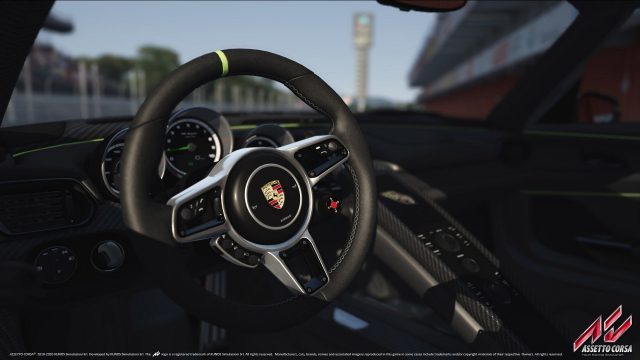
Assetto Corsa is a very popular sim, recognised for its intuitive physics and attractive visuals. Unlike most PC racing sims, it gives a significant amount of attention to road cars, giving the title a more mainstream appeal. Many prestigious brands are represented, including a vast collection of Ferrari and Porsche race and road cars. It also supports ‘mods’, and is now the go-to sim for user-created cars and tracks. Sometimes criticised for being a ‘hot-lap sim’ due to its basic career mode features, Assetto Corsa doesn’t offer the best single player experience – although its AI has improved. However, the game’s public multiplayer lobbies are very popular, making this the best choice for those looking for a quick race against human opponents.
The combination of slick visuals and sublime handling meant that even in the Oculus DK2 era—where no in-game menu system meant a limiting and painful setup process—Assetto Corsa was still worth trying. Since May 2016 however, the Rift has enjoyed much-improved support, and now Vive owners don’t have to mess with unofficial hacks for support as the game now natively supports OpenVR. An ‘IPD slider’ in the sim’s OpenVR app offers a solution to world scaling on Vive, and there is quick access to a cockpit camera adjustment.
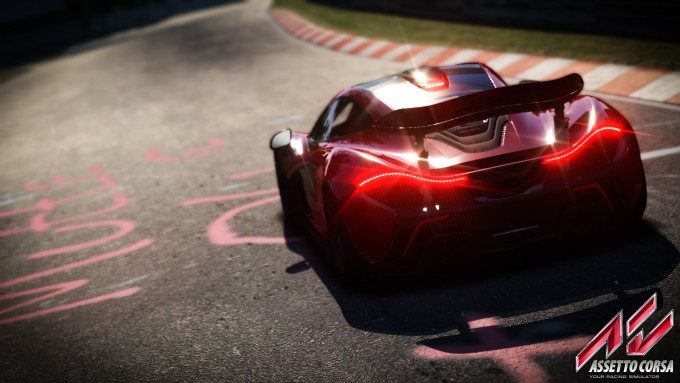 Today’s VR experience on Assetto Corsa is fairly painless. Unfortunately Kunos aren’t planning to implement a proper VR menu system, so you still need to launch the sim from a desktop view (although it is possible to operate this from a virtual desktop app). Once you’ve loaded a track, Assetto Corsa is stunning in VR, with smooth performance even on large grids, and excellent steering animations across all cars. The motion-to-photon latency is typically very low, improving your connection to the car and delivering a highly immersive experience. If your priority for VR immersion is low latency combined with high-quality visuals, Assetto Corsa strikes the best balance on this list.
Today’s VR experience on Assetto Corsa is fairly painless. Unfortunately Kunos aren’t planning to implement a proper VR menu system, so you still need to launch the sim from a desktop view (although it is possible to operate this from a virtual desktop app). Once you’ve loaded a track, Assetto Corsa is stunning in VR, with smooth performance even on large grids, and excellent steering animations across all cars. The motion-to-photon latency is typically very low, improving your connection to the car and delivering a highly immersive experience. If your priority for VR immersion is low latency combined with high-quality visuals, Assetto Corsa strikes the best balance on this list.
Unfortunately, it’s not perfect. The curved HUD and in-sim menu system isn’t the most elegant or intuitive, and the mirrors are inaccurate, rendering a single FOV across all cockpit mirrors. The basic ‘surround’ audio implemented on the Rift is welcome, but it still doesn’t work when using the Vive, and it can’t match the spatial audio system of Project CARS 2.
3. Live for Speed
By far the oldest product on the list (first seen in 2002), Live for Speed’s evolution has been painfully slow at times. In stark contrast, its VR updates across the last couple of years have been remarkably rapid—often industry-leading—implementing Rift and Vive support before either consumer hardware had even launched. The sim remains an impressive example of uncompromising driving physics, but visually it struggles to compete against the more recent titles, particularly with its ageing selection of (mostly) fantasy car models. Live for Speed is an ongoing project; 15 years of development updates have resulted in a unique, feature-laden simulation. The core driving experience is excellent, combining intuitive handling with strong force feedback.
Despite its dated visuals and fictional vehicles, Live for Speed remains a very interesting sim as a VR showcase. Its system requirements are very low, delivering 90Hz performance on sub-minimum spec machines, with a streamlined setup and comprehensive options to fiddle with. There are considerations for VR users not found in other sims, like a HUD-based keyboard (combined with a gaze-based pointer) for entering text, and a dedicated ‘walk’ mode intended to improve the experience of exploring the track environments in VR ‘on foot’.
Since version 0.6Q in September 2016, Live for Speed has featured stereoscopic mirrors, an effect first seen in Codemasters’ experimental VR support for GRID Autosport (2014). Live for Speed remains ahead of the competition here – it is the only racing sim on the list with the feature.
Interior and side mirrors in all other sims essentially appear like digital screens rather than reflections. iRacing and Project CARS 2 manage to move the mirror view relative to head position, but they’re still not stereoscopic. It might seem like an insignificant feature, but the effect of depth in mirrors has a remarkable impact for a number of reasons.
Firstly, it helps to mitigate the low resolution of current VR hardware; it’s hard enough to see distant objects in the main environment, and certainly troublesome to see detail in mirrors (many VR users opt to use a larger ‘virtual mirror’ as part of the HUD). Stereoscopic depth allows the eyes to resolve detail more easily. Secondly, there is the natural sensation of looking in a mirror—we expect them to work in a certain way, and it’s jarring when they don’t.
Due to the close proximity of the mirror itself, your eye’s convergence reflex is in full effect; when the virtual reflection is faked and appears as a ‘screen’, you’re having to look at the details as a close object, messing with your focal distance in an unnatural way. In Live for Speed, you look ‘through’ the mirrors as in reality, and focus on distant objects in the reflection in the same way as looking straight ahead.
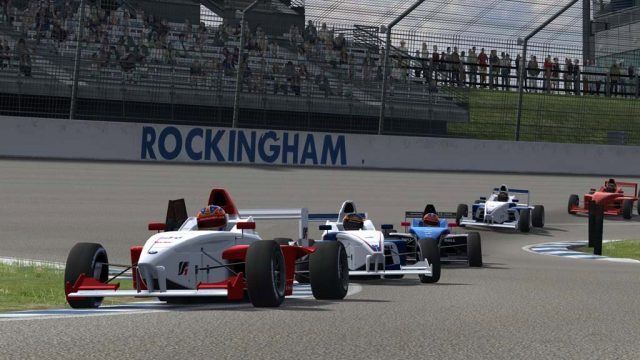 The effect is so convincing that I genuinely feel a heightened sense of presence, particularly when leaning up to the rear view mirror and seeing my own reflection (wearing a helmet) making exactly the same movement. All VR racing simulators should have this feature; unfortunately a mirror is one of the most performance-sapping elements to render. But once they do, ‘virtual mirrors’ on the HUD will likely be a thing of the past as they become completely unnecessary when the ‘real’ mirrors are so good.
The effect is so convincing that I genuinely feel a heightened sense of presence, particularly when leaning up to the rear view mirror and seeing my own reflection (wearing a helmet) making exactly the same movement. All VR racing simulators should have this feature; unfortunately a mirror is one of the most performance-sapping elements to render. But once they do, ‘virtual mirrors’ on the HUD will likely be a thing of the past as they become completely unnecessary when the ‘real’ mirrors are so good.
With huge performance headroom, Live for Speed always feels responsive in VR. Thanks to minimal latency on inputs and the 1:1 head movement in the stereoscopic reflections, LFS achieves a level of body presence that is a step above all other driving sims, despite the fact that the driver model is presented in very low detail by modern standards. It ticks almost every box for VR sim racing nirvana – perfect tracking, low latency, surround audio, 1:1 steering animation, and stereoscopic mirrors all contribute to powerful immersion, but it is let down by its dated visuals and a choppy world movement relative to head position – apparently due to the sim’s 100Hz physics update rate not matching the 90Hz rendering.

